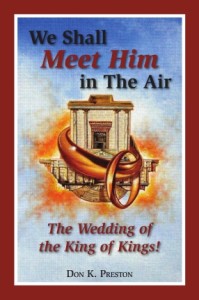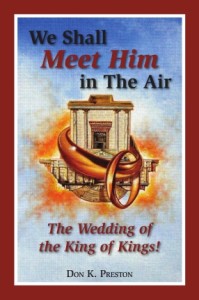My Analysis of Gary DeMar’s Response to Vern Poythress – #2

My Analysis of Gary DeMar’s Response to Vern Poythress – #2
Be sure to read part 1 of this three part series. My friend Gary DeMar addressed an article by Norm Poythress, in which Poythress attacked the idea that 2 Thessalonians 1 was fulfilled in AD 70. With acumen, insight, sound logic and good hermeneutic, DeMar literally dismantled Poythress’ futuristic application of 2 Thessalonians 1. The purpose of my analysis of DeMar’s article is to show that if he were consistent, he would adopt and promote the full preterist paradigm. I contend that the very hermeneutic that DeMar employs in his response to Poythress literally demands that 1 Thessalonians 4, which DeMar applies to a future coming of the Lord, is the same coming found in 2 Thessalonians 1 & 2, both passages that DeMar affirms were fulfilled in AD 70.
DeMar’s hermeneutic can be summarized in the following points:
Paul’s reference (in 2 Thessalonians 1 & 2) to the then current historical realities demands that we honor the audience relevance and application of his promises to that generation.
Paul’s use of the personal pronouns must be honored, and that demands that he was speaking to, about and of, the first century saints and events.
The inter-textual contact between Isaiah 66, Matthew 16:27-28 and other passages that pointed to the first century are directly parallel with 2 Thessalonians 1.
In the first installment, I took note how DeMar adduces nine direct parallels between the Olivet Discourse and 2 Thessalonians, concluding that those parallels demand a first century fulfillment. In light of this argument, I offered the following:
//Since that is true, then when we realize that there are (at the very least) nine direct parallels between Matthew 24:29-34 and 1 Thessalonians 4, this logically demands that 1 Thessalonians 4 also predicted the end of the Old Covenant age at the coming of the Lord in AD 70.
How can DeMar posit the parallels between Matthew 24 and 2 Thessalonians 2 as proof that they both speak of AD 70, and then turn around and deny that the even more specific, even more undeniable parallels between Matthew 24:29-34 and 1 Thessalonians 4 establish that 1 Thessalonians 4 was about AD 70? That is totally inconsistent! And keep in mind that we are not talking about simple “similarity of language.” We are talking about direct, verbal, linguistic, thematic and motival parallels.//
With this “refresher” information before us we come now to examine the direct parallels between 1 Thessalonians 4 and the Olivet Discourse. The reason I am producing the parallels between 1 Thessalonians 4 and the key texts in Matthew 24 is that DeMar is on record that the verses that we will examine in the Olivet Discourse predicted the Lord’s coming in AD 70. Thus, if it is demonstrated that the texts in Matthew 24 anticipated the Lord’s parousia in AD 70, and if 1 Thessalonians 4 posited the same precise tenets and motifs, not to mention the verbal parallels, then this proves that the parousia in 1 Thessalonians 4 must also be a prediction of the Lord’s coming in AD 70.
With that in mind, take note of the parallels between Matthew 24:29-34 and 1 Thessalonians 4:13-17, keeping in mind that DeMar teaches that the passages in Matthew do in fact speak of the coming end of the Old Covenant age: (A greatly expanded version of the chart can be found in my book, We Shall Meet Him In The Air, the Wedding of the King of kings. In that book, I have adduced well over 20 parallels between the two Thessalonian epistles and the entirety of the Olivet Discourse.
Temple Sermon and Olivet Discourse Thessalonians
1.) Matthew 24- Coming of Christ,
v. 3- parousia*
v. 27- parousia
v. 30- erchomai
v. 39- parousia
v. 42- erchomai
v. 44- erchomai Thessalonians- Coming of Christ,
Thessalonians:
1 Ths. 3:13- parousia
4:15- parousia
5:2- erchomai
5:23- parousia
2 Ths. 1:10- erchomai
2 Ths. 2:1, 8- parousia
Jesus’ two favorite words in the Olivet Discourse are the words Paul used the most in Thessalonians.
2.) Matthew 24:30- Coming with shout
1 Thessalonians 4:16- Coming with shout
3.) 24:30- With clouds– 1 Thessalonians 4:17- With clouds
4.) 24:30- With power and great glory.- 2 Thessalonians . 1:9-10- Coming to be glorified (cf. vs. 9, power and glory).
5. ) Matthew 24:30, 37-51; 25:31f- Judgment of the wicked — 2 Thessalonians. 1:7f- Judgment of the wicked
6. ) 24:31- Coming with angels 25:31- 1 Thessalonians 4:16- Coming with angels 4:16; 2 Thessalonians. 1:7-8 coming with angels-(draws from both sections!)
7.) Matthew 24:31-The sounding of the Trumpet — 1 Thessalonians 4:16-Trumpet.
8.) Matthew 24:31- Believers gathered -(episunagogee) — 1 Thessalonians 4:17- Believers gathered; 2 Thessalonians 2:1-concerning the gathering, (episunagogee).
9.) Matthew 24:34-This generation shall not pass till all fulfilled – 1 Thessalonians 4:15,17- We who are alive and remain until the coming (cf. 5:23.).**
* It should be noted that the word parousia meant more than the bodily presence of a person: “There were two contemporary uses of parousia which might have served as analogies for its distinctive Christian sense. One denoted the manifestation of a hidden divinity by some evidence of his power or in cultic action (this use is borrowed by Josephus to describe the coming of the God of Israel at various epochs in O. T. history; (cf. Antiq. 3:80, 203; 9. 55); the other denoted the official visit of a high-ranking personage to a province or city, when he was met on his approach by a deputation of leading citizens who escorted him formally for the remainder of his journey. In view of the near-divinization of some rulers, there can be no hard-and-fast distinction drawn between these two uses of parousia in the Hellenistic-Roman world.” (F. F. Bruce, Word Commentary, Commentary on 1 & 2 Thessalonians, (Waco, 1982, Vol. 45), 56-57).
What is to be noted is that Paul uses parousia in 1 Thessalonians 4, and, he uses the same word in 2 Thessalonians 2:1-3! DeMar (and Kenneth Gentry and other Postmillennialists) apply 2 Thessalonians 2 to AD 70, but they insist that 1 Thessalonians 4 is the end of time!
** – A note here on Paul’s use of “we who are alive.” It is commonly argued that Paul was using the “editorial we,” and that his language was just “stylistic.” This is untenable. Paul was clearly contrasting his contemporaries – those who were actually alive – with those Thessalonians that had died-the loved ones of the Thessalonians. His contrast is therefore very direct, between the dead of the brethren at Thessalonica and those at Thessalonica that were still alive – thus that generation. We have a right to ask why DeMar ignores this very powerful “audience relevance” reality. This is particularly relevant since DeMar tells us that, “One of the first things a Christian must learn in interpreting the Bible is to pay attention to the time texts. Failing to recognize the proximity of a prophetic event will distort its intended meaning. The New Testament clearly states that the ‘end of all things’ was at hand for those who first read 1 Peter 4:7; that is, the Old Covenant with its types and shadows was about to pass away.”
I fully concur and would press the point that, “we who alive and remain until the coming of the Lord” is a clear, unambiguous “time statement” unless one has a presuppositional theology to defend. Just as Paul affirmed concerning the resurrection, “Brethren, I tell you a mystery, we shall not all sleep” (1 Corinthians 15:51) the natural, normal, unforced reading of these statements is that Paul was fully expecting the resurrection to occur in his generation.
Clearly, the parallels in the chart above are impressive.. These comparisons show that Paul is indeed referring to the Olivet Discourse when he says, “This I say to you by the word of the Lord.” And let me remind the reader of a point made earlier.
In his 1994 book, Last Days Madness: Obsession of the Modern church, DeMar adduces nine parallels between the Olivet Discourse and 2 Thessalonians 2. He argues that since the parallels between 2 Thessalonians 2 and the tenets in the Olivet Discourse are so clear, and since the elements from the Olivet Discourse referred to the Lord’s coming in AD 70, that this demands that 2 Thessalonians 2 likewise predicted the parousia of AD 70. Since that is true, then when we realize that there are (at the very least) nine direct parallels between Matthew 24:29-34 and 1 Thessalonians 4, this logically demands that 1 Thessalonians 4 also predicted the end of the Old Covenant age at the coming of the Lord in AD 70.
And so, I ask again, How can DeMar posit the parallels between Matthew 24 and 2 Thessalonians 2 as proof that they both speak of AD 70, and then turn around and deny that the even more specific, even more undeniable parallels between Matthew 24:29-34 and 1 Thessalonians 4 establish that 1 Thessalonians 4 was about AD 70? That is totally inconsistent. And keep in mind that we are not talking about mere “similarity of language.” We are talking about direct, verbal, linguistic, thematic, motival parallels and temporal constraints.
The force and power of these parallels must be honored. We cannot allow long held, “traditional,” historical or “creedal” theology take precedent over the text itself.
In the next and final installment of this series I will examine some of the arguments that are given in an attempt to delineate between 1 Thessalonians 4 and 2 Thessalonians 1
In the meantime, get a copy of my book, We Shall Meet Him In the Air, the Wedding of the King of kings, for an in-depth examination of over 20 direct parallels between the Olivet Discourse and the Thessalonian epistles.

Hits: 36
The post My Analysis of Gary DeMar’s Response to Vern Poythress – #2 first appeared on DonKPreston.com.